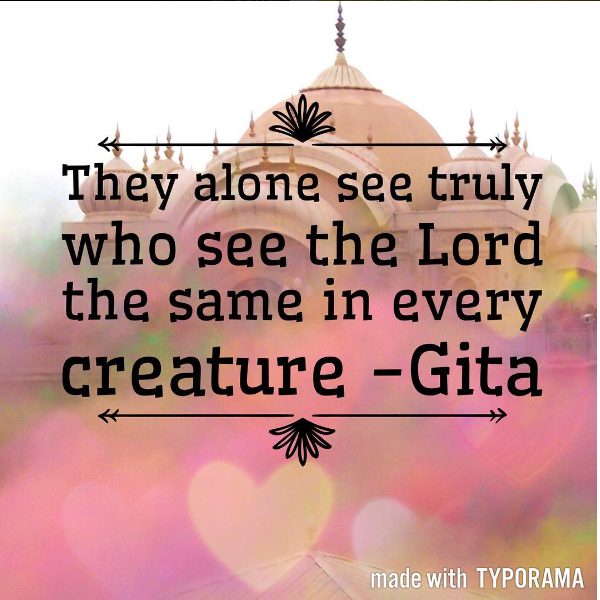If you know nothing else about Hinduism, you probably have at least heard of Krishna.
His name shows up in religious circles but also in pop culture. He’s one of the most recognizable figures in Hinduism with his blue skin and his flute.
Who is Krishna?
Stories
The life of Krishna is divided up into three distinct parts. There’s the stories of the baby Krishna and his mischievousness and miracles, then there are the stories of the teenage Krishna and his way with the cow herding girls (gopis), and then there is the middle aged Krishna who guides Arjuna on the path to self-realization in the Bhagavad Gita. He is said to have been born in the summer of 3228 BCE (his birthday, Krishna Janmashtami is celebrated every summer by Hindus) and he died in 3102.
(When I was a kid I had a Krishna comic book that I LOVED. Now I can’t remember which one it was!)
The first story to know is the birth of Krishna.
The evil king Kamsa overthrew his own father for the kingdom of Mathura. Hearing a prophecy that the eighth child of his sister, Devaki, would kill him, he imprisoned his sister and her husband, Vasudeva. Each time they had a child, the evil Kamsa would murder it. Devaki and Vasudeva prayed and at last Lord Vishnu appeared to them and told them that he himself would save them. When the eighth child is born, it is Vishnu in human form. With divine help, Vasudeva transports the child out of the prison, passing through many dangers and even through a sea that parts just for him, and switches the baby boy for a baby girl in the village of Gokula. When Kamsa attempts to kill this infant, she transforms into a goddess and tells him that his days are numbered.
Krishna is raised by Nanda and Yoshoda in Gokula. Many stories are told about how he loved to sneak butter and got the nickname the butter thief (makkhan chor). In one story, Yoshoda sees baby Krishna eating sand and she rushes over to tell him to stop. She pries open his mouth to remove the dirt, but what she sees is the entire universe contained in his throat. In another story Yoshoda gets frustrated with Krishna’s mischief and tries to tie him to a tree, but every rope she tries is somehow not long enough. Krishna is the entire world and cannot be contained.
Kamsa continues to hunt for the eighth child of Devaki, but Krishna defeats any demon sent for him. Eventually he faces his uncle and defeats him, restoring his grandfather to the throne of Mathura.
Next are the stories of teenage Krishna.
As a young man, Krishna delighted all the local girls with his beautiful flute playing. While tending cattle, Krishna and his friends teased their female friends and played tricks on one another. Krishna was known for always being up for play.
Many poems and songs are written about Krishna in this time of his life. One of the gopis in particular was his beloved. Her name was Radha. Poets for centuries have put themselves in Radha’s shoes and imagined themselves as the lovers of Krishna, awaiting his coming to them. This symbolizes the union of God and devotee. In particular, Mirabai is a poetess (For Love of the Dark One: Songs of Mirabai) known for her enormous devotion to Krishna and the stories say that her devotion saved her from the murder attempts her in-laws made against her.

The Bhagavad Gita.
The Gita is the “song of the Lord” and it is the conversation between Krishna and his friend Arjuna. By this time, Krishna is the king of Mathura and a powerful ally in a brewing war between the Pandavas and their cousins the Kaurava for the known world. From what I understand the system involved an overall king and then more minor kings under them who had smaller kingdoms. Krishna was a close family friend and he was part of the lives of all the cousins as they grew up.
In a lot of the story of the war it is not at all clear if anyone knows that Krishna is God. He lives much more like a regular person (regular king? Does that exist?) than in his earlier life. There aren’t the same miracles going on around him. He isn’t holding up mountains with his pinky finger anymore. Although, there are a few moments where it is clear that people do know. When Arjuna asks him to reveal his true form; when Draupadi calls on him to save her honor at the dice game; when the enemy tries to capture him and cannot contain him; when he gives the blind king sight for a few moments. So his friends know that he is God, yet he is also simply a friend.
So anyway, at one point both sets of cousins are gathering allies and representatives from both the Pandava (the good guys) and the Kauravas (the bad guys) show up at the house of Krishna looking for his support. Because he saw Arjuna first (common mistaken information: Arjuna is not the eldest of the Pandava nor is he in line to be the king. That would be his brother Yudishtira. But Arjuna is better known simply because of his presence in the Gita), Krishna gives him the choice of either Krishna’s own army, armed and loyal or Krishna himself, unarmed and not taking part in the battles at all.
Arjuna makes the right choice. He picks Krishna alone and asks him to steer his chariot during the war (which, actually, driving chariots is a lowly profession, something that has haunted Arjuna’s nemesis, Karna). The Kauravas think Arjuna has made a very stupid choice and are delighted to get Krishna’s army.
But when the two sides are lined up and ready to fight, it is Arjuna who must blow the conch shell to begin the war and looking across to the enemy he sees his uncle, his teachers, his friends, and his family on both sides and he falters. In that moment, Krishna teaches him the divine Truth and helps open his eyes to what he must do. Krishna tells him that it is his duty to fight. This war must be fought. But death is actually only an illusion, so he should not feel upset at having to kill his friends and relatives. At one point Arjuna asks to see Krishna’s true form, his divine form. Krishna eventually gives him and the description of him is awe-inducing and terrifying!
The Gita is not a long text, but it is dense with meaning and deserves its own post (or fifty)!
There is an important moment that is too often forgotten. Before the war begins, Krishna asks Arjuna to make sure that everything possible has been done to prevent the war. He also makes reference to the idea that the real war isn’t in the physical world at all, but within Arjuna’s soul.
Death
The war of The Mahabharata took a big toll on all its participants. It is said to have ushered in the dark age of the Kali Yuga (which we are currently in). Honorable practices were abandoned, rules were broken that had never been broken before. Though Krishna came to the war with the promise that he would not take part, he did manipulate a lot behind the scenes. He had the insight to know how things had to go and so he sometimes used whatever means necessary to get that outcome. (Analyzing Krishna’s actions during the war is another post I’d love to do sometime).
The mother of the Kaurava, Gandhari, felt that Krishna had cheated and in her grief, she cursed him. One of the interesting things about The Mahabharata is that every curse always comes true. When something is spoken, it has to happen. Gandhari says that Krishna will die alone and in rags. He says that he already knows this to be true. After some time Krishna retires to the forest to meditate (this was a standard practice for the end of one’s life and is still given as the part of the proper progression of life). His foot is mistaken for an animal and a hunter shoots and kills him, though Krishna forgives the hunter and tells him that it was fated to happen and it is all right. (Another interesting thing in The Mahabharata is how every action that happens has multiple sources and explanations. Anytime someone does something it is because of not only their present circumstances, but actions from past lives, and other forms of fate).
So Krishna dies alone in the forest.
God
Is Krishna a God in Hinduism? Yes, sort of. He is God in the form of a man, which is what the word avatar originally meant. He is actually a form of the God Vishnu, part of the Hindu trinity. Yet this form of Vishnu is so beloved that he is often worshiped directly as a God himself. There are people who focus their worship on each of the main three stages of Krishna. Some focus more on the baby Krishna and others on the teenager and others on the Krishna of the Gita.
There are some sects who see Krishna as God himself and not an avatar. They worship him as the supreme Lord. It is much more common that Krishna is worshiped as the most beloved of Vishnu’s avatars (well, perhaps on equal footing with Rama).
Symbolism
In images of Krishna you will often notice a flute, blue skin, peacock feathers, and in the case of baby Krishna, pots of butter (which don’t look like modern American butter!) There are various explanations for what these symbols mean. Blue skin has long been a way for artists to show a divine presence. Both Krishna and Shiva are nearly always shown with blue skin. Sometimes other Gods are as well.
The peacock feather, it seems, is just beautiful. It has become strongly attached to Krishna and is therefore seen as lucky (though some stories say it was unlucky in Krishna’s time and he changed that). In general peacock feathers are associated with nobility.
Some say the flute plays the sound of OM. Others say the flute represents the human heart, which should be emptied out to make room for Krishna to fill it with his breath.
The name “Krishna” means “dark one.”
The word “Govinda” is another name for Krishna.
The Original Jesus?
There are some interesting similarities in the stories told about Krishna and those told about Jesus. Krishna really originated this idea of a man who is both human and divine at the same time, one with a special and unusual connection to God. He also had a miraculous birth with a divine conception. He descended from heaven to save people and correct for evil in the world. He is a personal representation of God that we can become close to and have a personal relationship with. He performs miracles.
The similarities, however, are not as direct as some would like to believe they are. Most articles I found comparing the life of Krishna with the life of Jesus made some big stretches or had inaccurate information about Krishna.
I think it quite likely that some of the stories about Krishna filtered their way into legends about Jesus. There were thousands of years for them to spread and become part of the cultural backdrop of many civilizations, considering that Krishna was born more than 3 thousand years prior to Jesus.
They aren’t huge ah-ha! things, but little things. When I used to talk to Christian friends about it there would be these moments of, “Oh. They say that about Krishna too!” (The conversation would likely continue to something like, “Well, Hindus must have stolen ideas about Jesus.” “But Krishna lived thousands of years before Jesus.” “Hrmph. He didn’t rise from the dead, did he? That’s so much more impressive. That’s how we know Jesus is special.” “Hindus believe we can all come back from the dead. The stories of resurrection in the Bible sound an awful lot like just regular reincarnation to me. After all, his friends didn’t even recognize him!”
Worship of Krishna Is Best For
- Those who feel more comfortable with a personal God that they relate closely to
- Those who are drawn to devotional practices
- Those who appreciate humor and joy
- Those who find an infant God more approachable

















